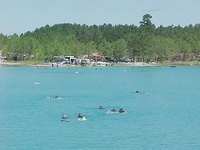
Blue Lagoon opened in September, 1986, as many improvements have been made since then. Lagoon II opened in March, effectively doubling the size of the facility. The operation is designed specifically for divers and especially for dive classes. Non-divers are permitted to come in with divers, but the lagoons are not open to swimmers. Pets are not permitted, both for safety reasons, and as a courtesy to other divers. There are three large dive platforms in Lagoon I and a second one has recently been sunk in Lagoon II, for a total of five. There are shelters around both lagoons to provide shade and equipment assembly areas for the dive classes, and gently sloping beaches for easy entry. Dive classes who wish to stay for the whole weekend camp right next to the water. A Huntsville dive store provides tank rentals and air refills. For certified divers, there is a separate area on the far side of Lagoon I that is close to the boat and the rock walls, and has a giant stride entry. Maximum depth in Lagoon I is 35’. The water temperature in the summer is 80-90 degrees. Although Blue Lagoon is located only 65 miles from Houston, most of the divers so far have come from Dallas. U/W photographer Stephan Myers comes up regularly from Houston to take advantage of the clear water for photography. “Most Houston divers just can’t believe that there can be clear water in a fresh water lake near Houston,” he says, “They probably remember their check out dives and think you have to go to Cozumel for clear water.” Myers appreciates the convenience of the lagoons’ clear water for photography. “It’s a lot easier to test a new technique or a piece of equipment in a place an hour away from home than on Palancar reef,” he added.
Scuba instructors like the convenience of conducting open water certification in clear of water free of competition. “We used to go to Canyon Lake,” Rebecca Tooley, an instructor from Humble, said, “but this is better. At Canyon, there was fishing line in the water, boaters, and crowds. There was more potential for trouble there. You just don’t have that potential here.”
Other instructors were enthusiastic about being able to take a whole class out to the platform at once without worrying about anyone getting lost in the murky water.
Open Water classes from as far away as Louisiana are taking advantage of the facility, and PADI recently held an Instructor Evaluation for 25 instructor candidates. Richard and Alan try to accommodate classes by reserving specific areas for each class to park their cars and to assemble their gear in order to keep classes together and keep confusion and inconvenience to a minimum.
In addition to student classes, several dive clubs have stared using the lagoons for club events. Last October, a dive store sponsored Halloween night dive, and there was an Easter Egg Hunt in April sponsored by a Houston club (some of the eggs are still waiting to be found). Night diving on the rock walls and boulder fields is especially exciting.
The secret of the lagoon’s clear water is its low pH. Filtering down through the pine needles covering the surrounding land lowers the pH too low to support the growth of algae. Unfortunately, it is also too low to support fish, but the trade off for clear water is worth it.
To keep the silt on the bottom down, Alan and Richard located a variety of salt grass that would grow in the low pH and have planted it in both lagoons.
“We tried putting in some chemicals to raise the pH,” Richard explained, “but the algae came right up so we decided to skip the fish and keep the clear water.”
The emphasis for the future at Blue Lagoon will be continued improvement of the facility. “We will be sinking more platforms for students and building more entry points,” Alan continued, “We are looking for more wrecks to sink for the certified divers. We have looked at a DC-3 airplane and some other boats as well.”
While looking for more underwater attractions, Richard and Alan continue “terra forming” the area around the lagoons, planting grass, and improving the roads and the camping areas. Night dives must be coordinated in advance, and it is a good idea to reserve space for classes or camping. Diving during the week usually provides the best visibility, as the Open Water students are not on hand to kick up the bottom.
For a little taste of Cozumel in the pines, dive Blue Lagoon!
http://www.bluelagoonscuba.com